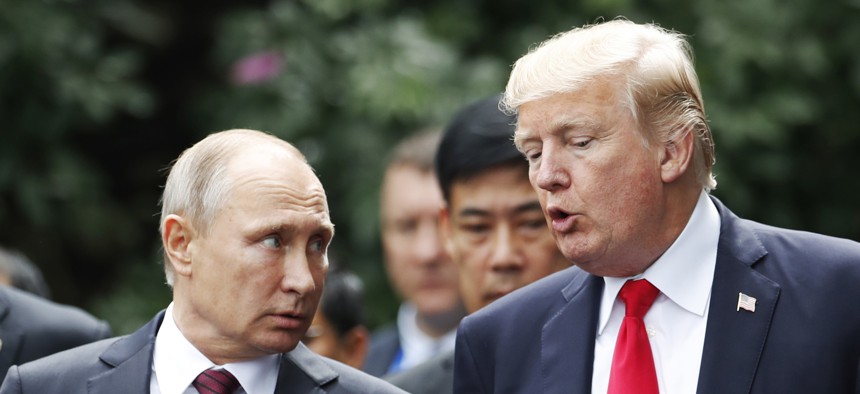
U.S. President Donald Trump and Russia's President Vladimir Putin talk during the family photo session at the APEC Summit in Danang, Vietnam, Saturday, Nov. 11, 2017. Jorge Silva/AP
Can Russia Help the US as Much as Trump Says It Can?
What the U.S. president may have in mind when he tweets about teaming up with Putin “to solve North Korea, Syria, Ukraine, terrorism."
Donald Trump has a message for the “haters and fools”—those who pounced on him when he suggested, aboard Air Force One this past weekend, that he placed greater faith in Vladimir Putin’s denials about interfering in the 2016 U.S. election than in the conclusions of the “political hacks” in his own intelligence agencies.
“Having a good relationship with Russia is a good thing, not a bad thing,” Trump tweeted. “I want to solve North Korea, Syria, Ukraine, terrorism, and Russia can greatly help!”
There’s a certain logic to the notion that we’re better off if the world’s largest military powers get along. But what specifically can Russia do to help resolve all these conflicts? Here’s a breakdown of what the president may have in mind.
North Korea
Russia isn’t nearly as central to the drama over North Korea’s nuclear weapons as is China, which has a defense treaty with North Korea, accounts for roughly 80 to 90 percent of North Korea’s trade, and can—by withdrawing this support—push Kim Jong Un’s government to the brink of collapse. But Russia is nevertheless the largest European source of North Korean imports, accounting for around 2 percent of total imports, and a past patron of the communist Kim government during the Cold War. And Russia, like China, borders North Korea, has participated in previous talks to restrict the North Korean nuclear program, and is a permanent member of the UN Security Council, which means its vote is critical to passing international sanctions.
Russia has backed tough but limited UN sanctions against North Korea over its nuclear and missile tests. It has adopted a similar position to China’s: that the United States and North Korea should both cease their provocations, make compromises, and enter into negotiations. But Putin’s government also seems to be playing what Reuters describes as a “double game,” perhaps to prevent the U.S. from toppling the Kim regime and extending its influence in East Asia right up to eastern Russia—just as America did with NATO forces on Russia’s western border. It has quietly tossed a lifeline to the North by, for instance, routing North Korean internet traffic through a Russian company and expanding trade in energy supplies with the North.
» Subscribed to The D Brief? Get the latest top national security and global military news delivered to your inbox every morning. Sign up here.
Trump acknowledged as much in his comments on Air Force One on Saturday. He noted that while his government has successfully convinced China to reduce its financial and trade ties with North Korea, as a means of pressuring North Korea to make concessions on its nuclear program, Russia “may be making up the difference. And if they are, that’s not a good thing.”
Syria
Russia and the United States are the most powerful countries involved in the Syrian Civil War, with the Russians on the side of Syrian President Bashar al-Assad and the Americans on the side first of anti-Assad rebels and, more recently, forces fighting ISIS. They are as crucial to ending the conflict as they have been to shaping and prolonging it.
Trump and Putin demonstrated this weekend that they are making progress on a peace settlement, issuing a statement in which they vowed to bring about a “political solution” to the Syrian war through constitutional reform and UN-supervised elections in which displaced Syrians abroad will be able to vote.
Such a deal, as Trump has pointed out, would save lives; a ceasefire brokered by Russia, the U.S., and Jordan this summer in southwestern Syrian has, in fact, already saved lives. But the peace plan is still aspirational rather than operational. And if peace is eventually achieved, a key question will be: On whose terms? The Trump administration has occasionally butted heads with Russia in Syria, such as when it launched strikes to punish Assad for using chemical weapons and shot down a Syrian warplane that was targeting U.S.-backed rebel fighters. But it has mostly focused on uprooting the Islamic State from the country, leaving the Russian air force and Iran-supported militias to strengthen Assad’s grip on the country. When a State Department official was recently asked whether Russia can actually get Assad to negotiate the potential end of his rule, as the United States would like, the official didn’t exactly sound confident. “We’re going to be testing that,” the official said. “We’re going to find out.”
Ukraine
Putin can technically help solve the conflict in Ukraine, but that’s kind of like saying Assad can help solve the conflict in Syria; the Russian leader is a prime instigator of the violence. In 2014, following an uprising that overthrew Ukraine’s Russia-allied president, Putin intervened militarily in the former Soviet republic, annexing the Crimean peninsula and aiding pro-Russia separatists in eastern Ukraine. The fighting has simmered, with periodic flare-ups, ever since.
While a peace process outlined in the Belarusian capital of Minsk has stalled, Russia is currently engaged in substantive debate with the United States and its European allies over how to constitute a peacekeeping force in eastern Ukraine. But some see Russia’s interest as a ploy to preserve the status quo and maintain leverage over a divided neighbor, just as Russia has orchestrated and exploited“frozen conflicts” in Georgia and Moldova.
Whether the peacekeepers materialize or not, the United States and Russia don’t look much like partners for peace at the moment—despite the apparent chumminess between Trump and Putin. The Trump administration is seriously considering supplying Ukraine with lethal defensive weapons even though the Kremlin opposes the move. In explaining why his government feels the need to equip Ukraine with such arms, the U.S. envoy for Ukraine peace talks, Kurt Volker, spoke to the scale of the obstacles to peace. “There are more Russian tanks in [Ukraine] than [tanks] in Western Europe combined,” he noted this summer.
Terrorism
Trump has long argued for reconciliation between the U.S. and Russia so that they can team up on a shared goal: destroying ISIS. And Russia does indeed have an interest in this; the Islamic State claims to have downed a Russian passenger jet over Egypt in 2015 and now draws more fighters from Russia than any other country, which heightens the terrorist threat to Russia as ISIS loses territory in Syria and Iraq and these militants return home. In their joint statement this weekend, Trump and Putin boasted that military-to-military communications between their countries had “dramatically accelerated ISIS’s losses on the battlefield” in Syria.
What Trump and Putin were really saying in that statement, however, is that the U.S. and Russia have (more or less) managed to not get in each other’s way as they go about their business in the civil war. While the Russian government insists that it’s fighting terrorism in Syria, it has trained most of its firepower on rebels battling Assad rather than on ISIS. When the Kremlin has announced assaults on the Islamic State, including the possible killing of ISIS leader Abu Bakr al-Baghdadi, the claims have often been difficult to verify and occurred in between major offensives against anti-Assad forces. This fall, as Assad’s opponents have dwindled, the Russian and Syrian militaries have once again gone on the attackagainst ISIS.
“Russia is not in Syria to defeat ISIS,” Genevieve Casagrande, a Syria analyst at the Institute for the Study of War, told me when rumors of Baghdadi’s death surfaced. It’s there, she said, to protect the Assad government and, by extension, Russia’s influence in the Middle East and military presence on the Mediterranean Sea. “Russia likes to portray itself as this marvelous counterterrorism actor that is in parallel and in lockstep with the U.S. against ISIS,” Casagrande noted, but it “typically only goes after ISIS when it is convenient for Russia.”
When you consider that thousands of people have been murdered in ISIS attacks, that 10,000 have been killed in the conflict in Ukraine, that hundreds of thousands have perished in the war in Syria, and that an untold number could lose their lives if fighting were to erupt on the Korean peninsula or between Russia and the United States, you can understand what Trump means when he warns that “people will die” because the U.S.-Russia relationship has become so dysfunctional—that the difference between cooperation and confrontation “isn’t baby stuff. This is the real deal.” These are the bleak statistics behind Trump’s remark this weekend that “I’d rather have [Putin] get out of Syria. ... I’d rather work with him on the Ukraine than standing and arguing about whether or not” he messed with the U.S. election.
But Trump’s insight isn’t new. As the Russia scholar Angela Stent has documented, each American president since the end of the Cold War has recognized that Russia and the United States are great powers that together could do great things to solve the world’s worst problems. Bill Clinton played the sax with Boris Yeltsin. George W. Bush peered into Putin’s soul. Barack Obama, as Trump likes to point out with disdain, sent Hillary Clinton to Russia with a “reset” button.
These dreams have repeatedly been dashed for the same reason: The divergent ways that the U.S. and Russia view the world and their own interests have proven more powerful than the incentives to join forces. Under Clinton, the breaking point was NATO’s expansion into Central and Eastern Europe and military intervention against Yugoslavia. Under Bush, it was Russia’s invasion of Georgia. Under Obama, it was Russia’s apparent campaign to undermine American democracy. Trump claims he has “what it takes” to call up Putin, make a deal, and get Russia to “pull back” from North Korea, Syria, and Ukraine. This plan, however, doesn’t account for the stubborn realities that the United States is committed to denuclearizing North Korea while Russia is ready to settle for a less provocative North Korea with nuclear weapons; that Russia prioritizes the Assad government’s survival in Syria while the United States prioritizes ISIS’s destruction; that the United States wants a united and independent Ukraine while Russia desires a divided and dependent satellite state.
In casting doubt on whether the Russian government meddled in the U.S. presidential race, in rejecting the allegation as an “artificial Democratic hit job,” Trump isn’t just defying the assessment of the government he leads. He’s also making a broader argument: that America’s fundamental differences with Russia—including on matters at the core of the American system of government—should be downplayed or dismissed for the sake of “good relations.”




